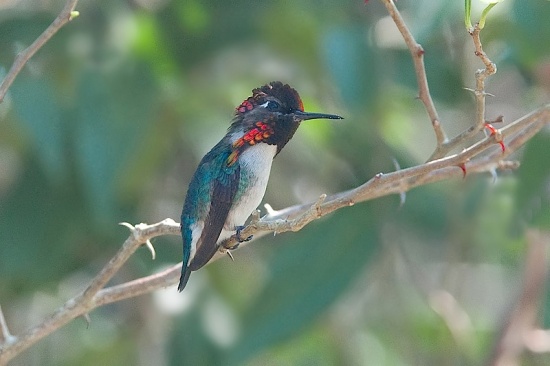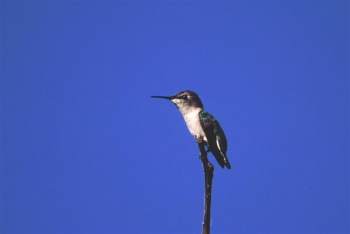(Add External Link) |
(→External Links: Multiple GSearches combined) |
||
| (8 intermediate revisions by 2 users not shown) | |||
| Line 1: | Line 1: | ||
| + | [[Image:Bee_Hummingbird.jpg|thumb|550px|right|Photo by {{user|rb_stern|Richard Stern}}<br />Photo taken at Maria la Gorda, Pinar del Rio Pro., [[Cuba]], February 2009<br />Click on photo for larger image]] | ||
;[[: Category:Mellisuga|Mellisuga]] helenae | ;[[: Category:Mellisuga|Mellisuga]] helenae | ||
==Identification== | ==Identification== | ||
| − | At 5cm, the Bee Hummingbird is the smallest bird in the world | + | At 5cm, the Bee Hummingbird is the smallest bird in the world<br /> |
| − | + | '''Male''' | |
| − | '''Male''' | + | *Green crown |
| − | + | *Red throat | |
| − | ''' Female''' | + | *Iridescent gorget, with elongated lateral plumes |
| + | *Bluish upper-parts | ||
| + | *Greyish white underparts | ||
| + | *Slender pointed bill<br /> | ||
| + | Breeding males have red-pink head, chin and throat<br /> | ||
| + | Non breeding males have blue spots to their wingtips<br /> | ||
| + | [[Image:Bee Hummingbird Feb 12 26.jpg|thumb|350px|right|Female<br />Photo by {{user|dragnil|dragnil}}<br />Zapata, [[Cuba]], February 2012]] | ||
| + | ''' Female''' | ||
| + | *Green above | ||
| + | *Pale grey below | ||
| + | *White tips to the outer tail feathers<brc/> | ||
| + | While more apt to be mistaken for a bee than a bird because of the size, the bird is not a mimic. | ||
==Distribution== | ==Distribution== | ||
| − | The Bee Hummingbird is endemic to [[Cuba]] | + | The Bee Hummingbird is endemic to [[Cuba]] and Isle of Pines |
| − | |||
==Taxonomy== | ==Taxonomy== | ||
| − | + | This is a [[Dictionary_M-O#M|monotypic]] species; no subspecies are known.<sup>[[#References|[1]]]</sup> | |
==Habitat== | ==Habitat== | ||
Woodland, shrubbery, and gardens. | Woodland, shrubbery, and gardens. | ||
| − | |||
==Behaviour== | ==Behaviour== | ||
| − | + | ====Diet==== | |
| − | + | [[Image:Mellisuga helenae eclypse.jpg|thumb|350px|right|Eclipse plumage<br />Photo by {{user|opfister|opfister}}<br />[[Zapata National Park]], [[Cuba]], November 2004 ]] | |
| − | The female builds a cupshaped nest from cobwebs, bark,and lichen, lined with soft plant fibres. 2 bright orange with pink spots | + | Nectar is an important part of the diet. Bee hummingbird seems to be a nectar generalist, one that uses flowers also utilized by bees and other insects as well as the [[Cuban Emerald]]. |
| − | + | ====Breeding==== | |
| − | + | The female builds a cupshaped nest from cobwebs, bark,and lichen, lined with soft plant fibres. The 2 bright orange eggs with pink spots are incubated by the female, who also raises the young. | |
| − | |||
| − | |||
| + | ==References== | ||
| + | #{{Ref-Clements6thAug13}}#Wikipedia | ||
| + | #Arthur Grosset | ||
| + | #Dalsgaard et al. 2012. Ornithologia Neotropical 23:143-149 | ||
| + | {{ref}} | ||
==External Links== | ==External Links== | ||
*[http://www.arthurgrosset.com/sabirds/beehummingbird.html Arthur Grosset's Birds] | *[http://www.arthurgrosset.com/sabirds/beehummingbird.html Arthur Grosset's Birds] | ||
| − | {{GSearch|Mellisuga | + | <br /> |
| + | {{GSearch|"Mellisuga helenae" {{!}} "Bee Hummingbird"}} | ||
| + | {{GS-checked}} | ||
| + | <br /> | ||
| + | <br /> | ||
| − | [[Category:Birds]][[Category:Mellisuga | + | [[Category:Birds]][[Category:Mellisuga]] |
Latest revision as of 22:52, 12 December 2022

Photo taken at Maria la Gorda, Pinar del Rio Pro., Cuba, February 2009
Click on photo for larger image
- Mellisuga helenae
Identification
At 5cm, the Bee Hummingbird is the smallest bird in the world
Male
- Green crown
- Red throat
- Iridescent gorget, with elongated lateral plumes
- Bluish upper-parts
- Greyish white underparts
- Slender pointed bill
Breeding males have red-pink head, chin and throat
Non breeding males have blue spots to their wingtips
Female
- Green above
- Pale grey below
- White tips to the outer tail feathers<brc/>
While more apt to be mistaken for a bee than a bird because of the size, the bird is not a mimic.
Distribution
The Bee Hummingbird is endemic to Cuba and Isle of Pines
Taxonomy
This is a monotypic species; no subspecies are known.[1]
Habitat
Woodland, shrubbery, and gardens.
Behaviour
Diet
Nectar is an important part of the diet. Bee hummingbird seems to be a nectar generalist, one that uses flowers also utilized by bees and other insects as well as the Cuban Emerald.
Breeding
The female builds a cupshaped nest from cobwebs, bark,and lichen, lined with soft plant fibres. The 2 bright orange eggs with pink spots are incubated by the female, who also raises the young.
References
- Clements, J. F., T. S. Schulenberg, M. J. Iliff, B.L. Sullivan, C. L. Wood, and D. Roberson. 2013. The eBird/Clements checklist of birds of the world: Version 6.8., with updates to August 2013. Downloaded from http://www.birds.cornell.edu/clementschecklist/download/
- Wikipedia
- Arthur Grosset
- Dalsgaard et al. 2012. Ornithologia Neotropical 23:143-149
Recommended Citation
- BirdForum Opus contributors. (2024) Bee Hummingbird. In: BirdForum, the forum for wild birds and birding. Retrieved 10 June 2024 from https://www.birdforum.net/opus/Bee_Hummingbird
External Links
GSearch checked for 2020 platform.





